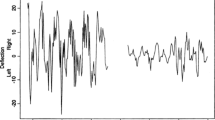Abstract
Terrestrial technology is now, and increasingly, sensitive to space weather. Most space weather is caused by solar storms and the resulting changes to the Earth's radiation environment and the magnetosphere. The Sun as the driver of space weather is under intense observation but remains to be adequately modelled. Recent spacecraft measurements are greatly improving models of solar activity, the interaction of the solar wind with the magnetosphere, and models of the radiation belts. In-situ data updates the basic magnetospheric model to provide specific details of high-energy electron flux at satellite orbits. Shock wave effects at the magnetopause can also be coarsely predicted. However, the specific geomagnetic effects at ground level depend on the calculation of magnetic and electric fields and further improvements are needed. New work on physical models is showing promise of raising geomagnetic and ionospheric predictability above the synoptic climatological level.
Similar content being viewed by others
References
Baker, D. N.: 2001, ‘Satellite Anomalies due to Space Storms’, in I. A. Daglis (ed.), Space Storms and Space Weather Hazards, Kluwer Academic Publishers, NATO Science Series, Dordrecht.
Chao, J. K. and Chen, H. H.: 2001, ‘Prediction of Southward IMF Bz’, in P. Song, H. J. Singer, and G. L. Siscoe (eds), Space Weather, AGU Geophysical Monograph Series, Volume 125, Washington.
Geological Survey of Canada: 2002, ‘Space Weather Effects on Technology’, <http://www.spaceweather.gc.ca/effects_e.shtml>.
Hesse, M., Kuznetsova, M., Rastaetter, L., Keller, K. and Falasca, A.: 2003, ‘Space Weather Model Testing and Validation at the Community Coordinated Modeling Center’, this volume. ISES: 2003, http://www.ises-spaceweather.org/about_ises/index.html.
Kamide, Y., Kihn, E. A. and Cliver, E. W.: 2003, ‘Real-time Specification of the Geospace Environment’, this volume.
Kappenman, J. G.: 2001, ‘An Introduction to Power Grid Impacts and Vulnerabilities from Space Weather’, in I. A. Daglis (ed.), Space Storms and Space Weather Hazards, Kluwer Academic Publishers, NATO Science Series, Dordrecht.
Leibacher, J. W. and the GONG Project Team: 1998, ‘The Global Oscillation Network Group (GONG) Project’, in A. Wilson (ed.), Structure and Dynamics of the Interior of the Sun and Sun-Like Stars, SOHO 6/GONG 98, SP-418.
Lindsey, C. and Braun, D. C.: 2000, ‘Basic Principles of Solar Acoustic Holography’, Solar Phys. 192/1-2, p261.
Moorer, D. F. Jr. and Baker, D. N.: 2001, 'specification of Energetic Magnetospheric Electrons’, in P. Song, H. J. Singer, and G. L. Siscoe (eds), Space Weather, AGU Geophysical Monograph Series, Volume 125, Washington.
Raeder, J., Wang, Y. and Fuller-Rowell, T. J.: 2001, ‘Geomagnetic Storm Simulation with a Coupled Magnetosphere-ionosphere-thermosphere Model’, in P. Song, H. J. Singer, and G. L. Siscoe (eds), Space Weather, AGU Geophysical Monograph Series, Volume 125, Washington.
Reeves, G. D., McAdams, K. L., Friedel, R. H. W. and Cayton, T. E.: 2001, ‘The Search for Predictable Features of Relativistic Electron Events: Results from the GEM Storms Campaign’, in P. Song, H. J. Singer, and G. L. Siscoe (eds), Space Weather, AGU Geophysical Monograph Series, Volume 125, Washington.
Schatten, K. H., Myers, D. J. and Sofia, S.: 1996, ‘Solar Activity Forecast for Solar Cycle 23’, Geophys.Res.Lett. 23(6), p605-608.
Scholer, M.: 2001, ‘Global Magnetospheric Modelling: Methods, Results and Open Questions’, in I. A. Daglis (ed.), Space Storms and Space Weather Hazards, Kluwer Academic Publishers, NATO Science Series, Dordrecht.
Thompson, R. J.: 1993, ‘A Technique for Predicting the Amplitude of the Solar Cycle’, Solar Phys. 148, p383.
Toffoletto, F., Sazykin, S., Spiro, R. and Wolf, R.: 2003, ‘Modelling the Inner Magnetosphere’, this volume.
Wilkinson P., Patterson, G., Cole, D., Yuile, C., Wang, Y-J., Tripathi, Y., Marshall, R., Thompson, R. and Phelan, P.: 2000, ‘Australian Space Weather Services’, Adv.Space Res. 26(1), p233.
Author information
Authors and Affiliations
Rights and permissions
About this article
Cite this article
Cole, D.G. Space weather: its effects and predictability. Space Science Reviews 107, 295–302 (2003). https://doi.org/10.1023/A:1025500513499
Issue Date:
DOI: https://doi.org/10.1023/A:1025500513499




